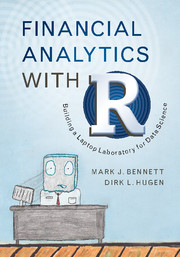Book contents
- Frontmatter
- Dedication
- Contents
- Preface
- Acknowledgments
- 1 Analytical Thinking
- 2 The R Language for Statistical Computing
- 3 Financial Statistics
- 4 Financial Securities
- 5 Dataset Analytics and Risk Measurement
- 6 Time Series Analysis
- 7 The Sharpe Ratio
- 8 Markowitz Mean-Variance Optimization
- 9 Cluster Analysis
- 10 Gauging the Market Sentiment
- 11 Simulating Trading Strategies
- 12 Data Exploration Using Fundamentals
- 13 Prediction Using Fundamentals
- 14 Binomial Model for Options
- 15 Black–Scholes Model and Option-Implied Volatility
- Appendix Probability Distributions and Statistical Analysis
- References
- Index
11 - Simulating Trading Strategies
Published online by Cambridge University Press: 20 October 2016
- Frontmatter
- Dedication
- Contents
- Preface
- Acknowledgments
- 1 Analytical Thinking
- 2 The R Language for Statistical Computing
- 3 Financial Statistics
- 4 Financial Securities
- 5 Dataset Analytics and Risk Measurement
- 6 Time Series Analysis
- 7 The Sharpe Ratio
- 8 Markowitz Mean-Variance Optimization
- 9 Cluster Analysis
- 10 Gauging the Market Sentiment
- 11 Simulating Trading Strategies
- 12 Data Exploration Using Fundamentals
- 13 Prediction Using Fundamentals
- 14 Binomial Model for Options
- 15 Black–Scholes Model and Option-Implied Volatility
- Appendix Probability Distributions and Statistical Analysis
- References
- Index
Summary
Stories abound about people who say they bought a house 30 years ago, and it is now worth many times the purchase price. Staying invested in the housing market has historically been a safe bet. Just like a long-term investor in the housing market, a long-term individual stock market investor expects an upward-trending stock market when viewed decade by decade. The stock market investor remains in a long position, “long the stock market,” until they decide to liquidate the position and realize any gains. In many cases this happens upon their retirement. This form of investing is one type of conservative strategy known as trend following: following the long-term upward trend until the desired profitability is achieved or until holding on to the investment is no longer feasible.
This chapter is all about trend following on a much more short-term basis: a matter of minutes or hours. It builds upon the market sentiment ideas of Chapter 10 and extends them.
Foreign Exchange Markets
If a United States corporation is expecting to make payments for purchased products in the Euro currency, they need to hedge their exposure to the Euro until the day the payment is required. Economically speaking, if the Euro increases in value before the payment date, and we wait to convert over our US currency into Euros, the payment effectively increases in value, against our will. The situation the company is in ends up being part of a trading strategy. A trend-following strategy to hedge exposure to the Euro involves buying the Euro and selling US Dollars at a point when the Euro is expected to increase or strengthen in value. If we own a forward or futures contract – the right to buy Euros at 1.1400 in the future – and the Euro currency then increases in value, as the Euros get more valuable we take comfort from the fact that we locked in at 1.1400, the lower rate. We tailor a contract to do this as long we think it is likely that an upward trend for Euro will exist. So, even though we just needed to make a payment, we are becoming a trader in the market.
Going beyond this simple payment example, for people speculating or hedging their long-term exposure to currency rates, another strategy is common.
- Type
- Chapter
- Information
- Financial Analytics with RBuilding a Laptop Laboratory for Data Science, pp. 261 - 280Publisher: Cambridge University PressPrint publication year: 2016



